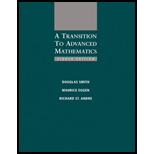
a.
Prove that an infinite subset of a denumerable set is denumerable.
a.
Answer to Problem 9E
Proved
Explanation of Solution
Given information:
Use the theorems of this section.
Calculation:
We have to use the theorem to prove an infinite subset of a denumerable set is denumerable.
A denumerable set
Every subset of a countable set is countable so
Since
Hence, an infinite subset of a denumerable set is denumerable.
b.
Prove that if
b.
Answer to Problem 9E
Proved
Explanation of Solution
Given information:
Use the theorems of this section.
Calculation:
We have to use the theorem to prove
Consider an uncountable set
It implies that set
The assumption
Hence, if
c.
Prove that
c.
Answer to Problem 9E
Proved
Explanation of Solution
Given information:
Use the theorems of this section.
Calculation:
We have to use the theorem to prove
The set
Hence,
d.
Prove that
d.
Answer to Problem 9E
Proved
Explanation of Solution
Given information:
Use the theorems of this section.
Calculation:
We have to use the theorem to prove
The set
The set
Since the set
Hence,
The set
Hence,
e.
Prove that
e.
Answer to Problem 9E
Proved
Explanation of Solution
Given information:
Use the theorems of this section.
Calculation:
We have to use the theorem to prove
The set
Hence,
f.
Prove that
f.
Answer to Problem 9E
Proved
Explanation of Solution
Given information:
Use the theorems of this section.
Calculation:
We have to use the theorem to prove
The set
Since the set of natural numbers is denumerable. the countable collection of countable sets is countable.
Hence,
Want to see more full solutions like this?
Chapter 5 Solutions
A Transition to Advanced Mathematics
- Using Karnaugh maps and Gray coding, reduce the following circuit represented as a table and write the final circuit in simplest form (first in terms of number of gates then in terms of fan-in of those gates).arrow_forwardConsider the alphabet {a, b, c}.• Design a regular expression that recognizes all strings over {a, b, c} that have at least three nonconsec-utive c characters (two characters are non-consecutive if there is at least one character between them)and at least one a character.• Explain how your regular expression recognizes the string cbbcccac by clearly identifying which partsof the string match to the components of your regular expressionarrow_forwardComplex Analysis 2 z3+3 Q1: Evaluate cz(z-i)² the Figure. First exam 2024-2025 dz, where C is the figure-eight contour shown inarrow_forward
- Construct a state-level description (i.e., a state diagram with transitions) for aTuring machine that decides the language {a^(n)b^(2n)c^(n) | n ∈ N}.arrow_forwardFind the sum of products expansion of the function F (x, y, z) = ̄x · y + x · z in two ways: (i) using a table; and (ii) using Boolean identitiesarrow_forwardThe NOR operator, denoted as ↓, behaves as 0 ↓ 0 = 1, 0 ↓ 1 = 0, 1 ↓ 0 = 0,1 ↓ 1 = 0. Show that the any Boolean function over any number of variables can be expressed using onlyNOR operators (in addition to those variables and constants). HINT: Recall that any Boolean function hasa representation as a sum of products expansionarrow_forward
- Consider the Turing machine given in lecture which decides the languageB = {w#w | w is a binary string}.Simulate the Turing machine to show that the string 1001#1001 will be accepted by the Turing machine. Show all steps.arrow_forwardQ/Find the Laurent series of (2-3) cos↓ around z = 1. 2-1arrow_forward#1). A technique is given with 150 mAs is 40 kV and produces an EI value = 400. Find the new EI value, if mAs is 75 and 34 kV are used.arrow_forward
- Q3: Answer the following: (i) Let f(z) is an analytic function in a simply connected domain S and y is a simple, closed, positively oriented contour lying in S. Prove that f, f(z)dz = 0.arrow_forwardUse the method of undetermined coefficients to solve the given nonhomogeneous system.X' = −1 33 −1 X + −4t2t + 2 X(t) =arrow_forwardDetailed report without CHATGPT, accept if you can give with code and plots, previous reported . Do not waste my question.arrow_forward
 Holt Mcdougal Larson Pre-algebra: Student Edition...AlgebraISBN:9780547587776Author:HOLT MCDOUGALPublisher:HOLT MCDOUGAL
Holt Mcdougal Larson Pre-algebra: Student Edition...AlgebraISBN:9780547587776Author:HOLT MCDOUGALPublisher:HOLT MCDOUGAL Algebra: Structure And Method, Book 1AlgebraISBN:9780395977224Author:Richard G. Brown, Mary P. Dolciani, Robert H. Sorgenfrey, William L. ColePublisher:McDougal LittellAlgebra & Trigonometry with Analytic GeometryAlgebraISBN:9781133382119Author:SwokowskiPublisher:Cengage
Algebra: Structure And Method, Book 1AlgebraISBN:9780395977224Author:Richard G. Brown, Mary P. Dolciani, Robert H. Sorgenfrey, William L. ColePublisher:McDougal LittellAlgebra & Trigonometry with Analytic GeometryAlgebraISBN:9781133382119Author:SwokowskiPublisher:Cengage
 Big Ideas Math A Bridge To Success Algebra 1: Stu...AlgebraISBN:9781680331141Author:HOUGHTON MIFFLIN HARCOURTPublisher:Houghton Mifflin Harcourt
Big Ideas Math A Bridge To Success Algebra 1: Stu...AlgebraISBN:9781680331141Author:HOUGHTON MIFFLIN HARCOURTPublisher:Houghton Mifflin Harcourt




